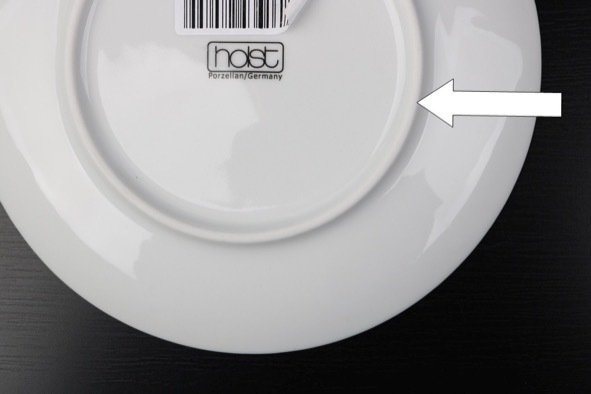Bottom rings

The surface on which the porcelain is placed during hard firing is called the setting ring, also known as the web or bottom web in the case of rectangular plates. It is the contact point between the porcelain article and the carrier plate. To ensure the longevity of the carrier plate as a firing aid, it is important that the adjusting rings are freed from the glaze mass again by wet polishing after glazing. In other words, the glaze liquid must be "washed off" from the set collars. If a plate with a glazed collar were fired, it would be firmly attached to the carrier plate after firing and would not be able to be detached from it.
Large plates - usually from 29 cm - and platters usually have several setting rings. This is necessary to maintain stability during the firing process. If the collar would not stabilize the flat surface, the porcelain could easily sink down during the firing and the plate would end up with waves. In the case of plates and platters with a large surface area, it is an unavoidable result of production-related circumstances that the set collars become visible on the upper side.
After hard firing, the ring shows the fired body. If the glazed surfaces have the same white color as the unglazed base rings, it is undoubtedly porcelain. Read more about the determination of materials here. As a rule, the collar is polished after firing to remove all sharp edges and unevenness.
Since, as already mentioned, porcelain has a Mohs' hardness between 5 and 7, the corresponding grinding stones and grinding papers must be of extremely high quality. Such "diamond paper" costs a lot of money and wears out after only a short time of use.
Therefore, the smoothness of a porcelain ring is usually directly related to the price. Here the rule of thumb applies: The larger or the cheaper a porcelain item is, the coarser the ring is. Small uneven spots, bulges or holes do not impair the function of a set collar. The porcelain should simply not "dance" - i.e. lose its stability - or show sharp-edged residues. We at Holst Porzellan attach great importance to "sensibly" polished set collars and regularly instruct our partners in the care of this work step.
Application instructions for porcelain with bottom rings:
- According to our general instructions for use of Porcelain, you should always check each porcelain component carefully before use. This also includes possible glaze residues or sharp-edged breakouts of the set collars. Glaze residues can be easily removed with a hard object or a file. In case of large, sharp-edged break-outs of the set collars, it must be assessed whether this impairs the intended use and, if necessary, should not be used
- For safety reasons, please always use underlays (tablecloths, placemats, etc.) to protect against scratches when using on sensitive surfaces
- Never push and pull porcelain on porcelain. Rinsing residues such as lime, quartz and crystals act like sandpaper between the adjusting ring and glaze and contribute to the fact that glazes are scratched by this improper, mechanical stress
